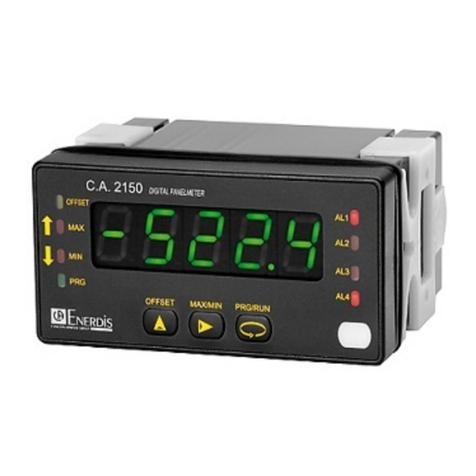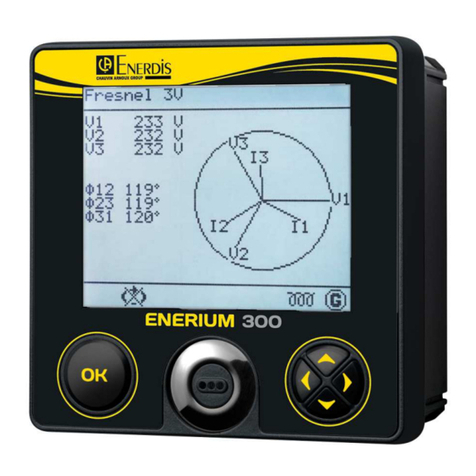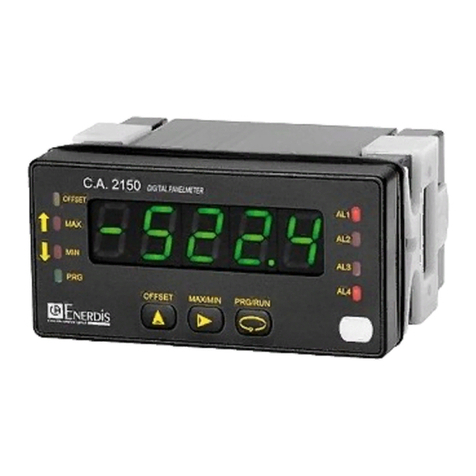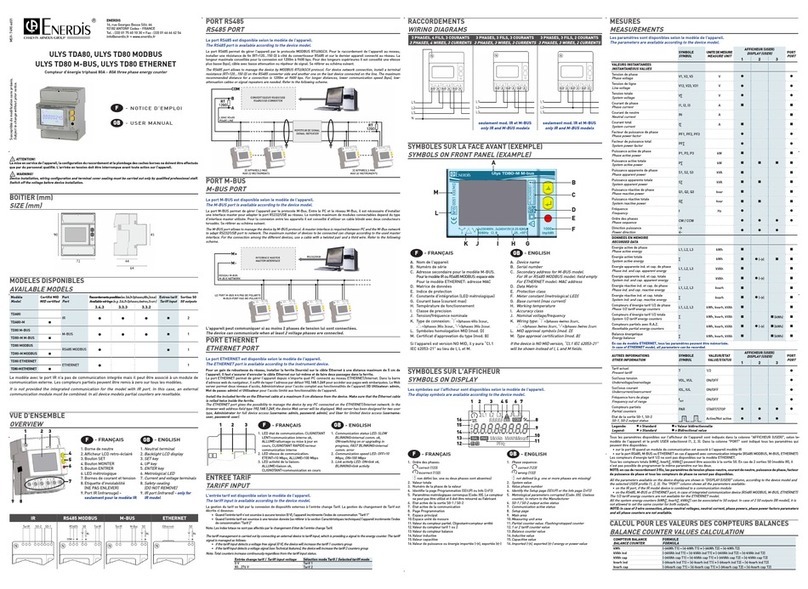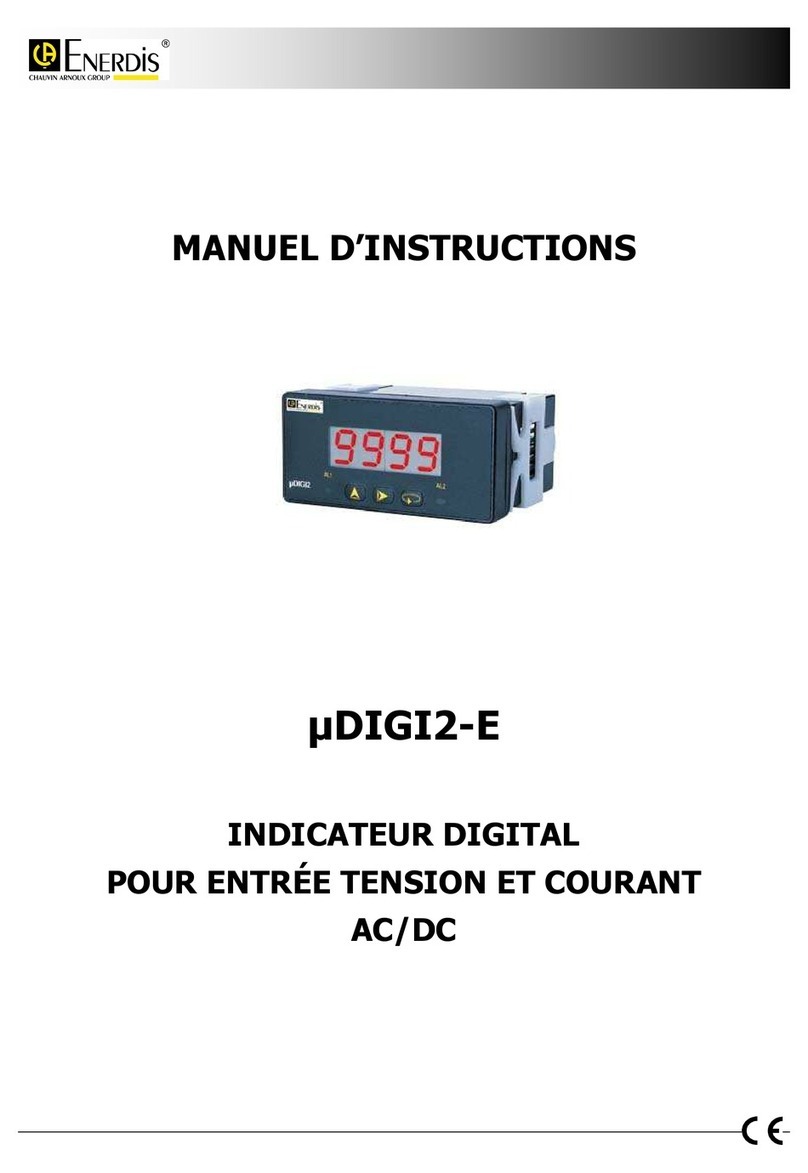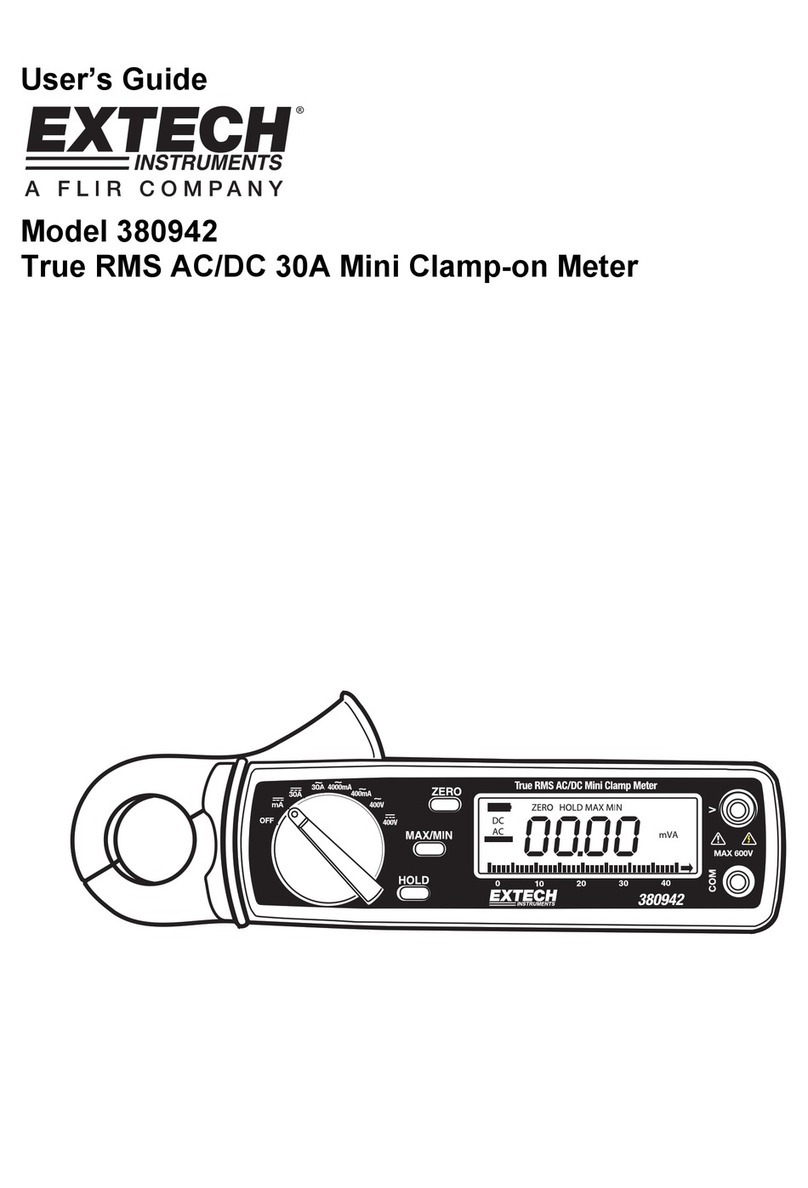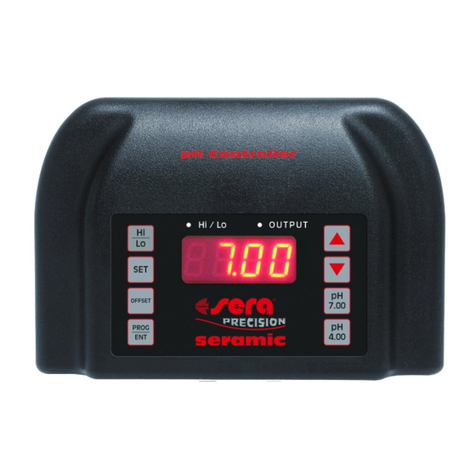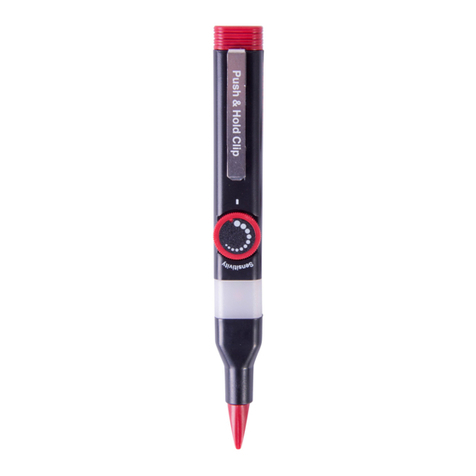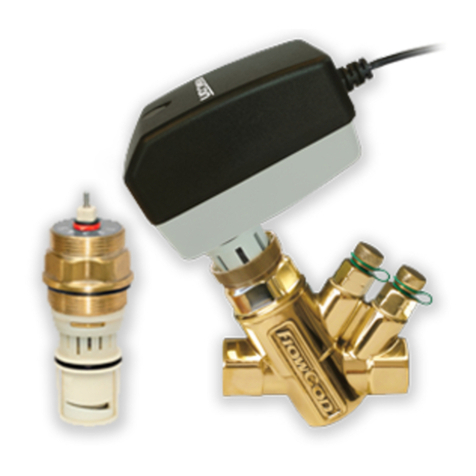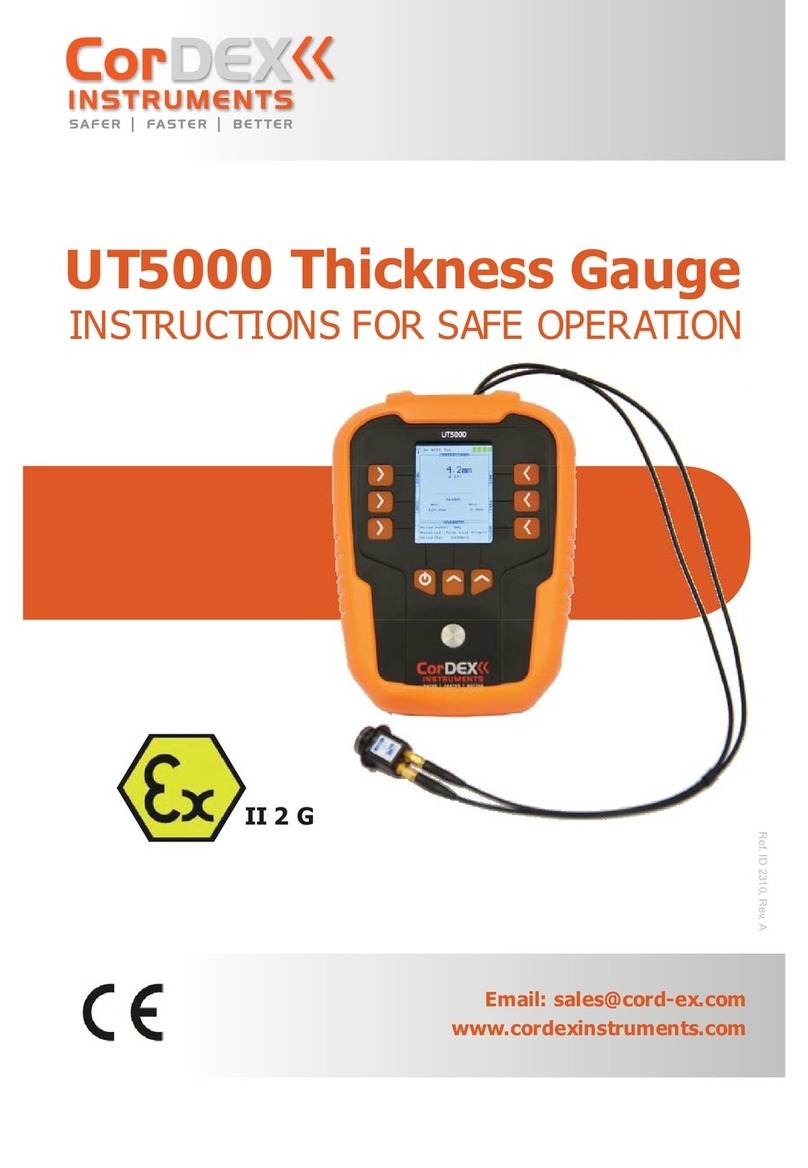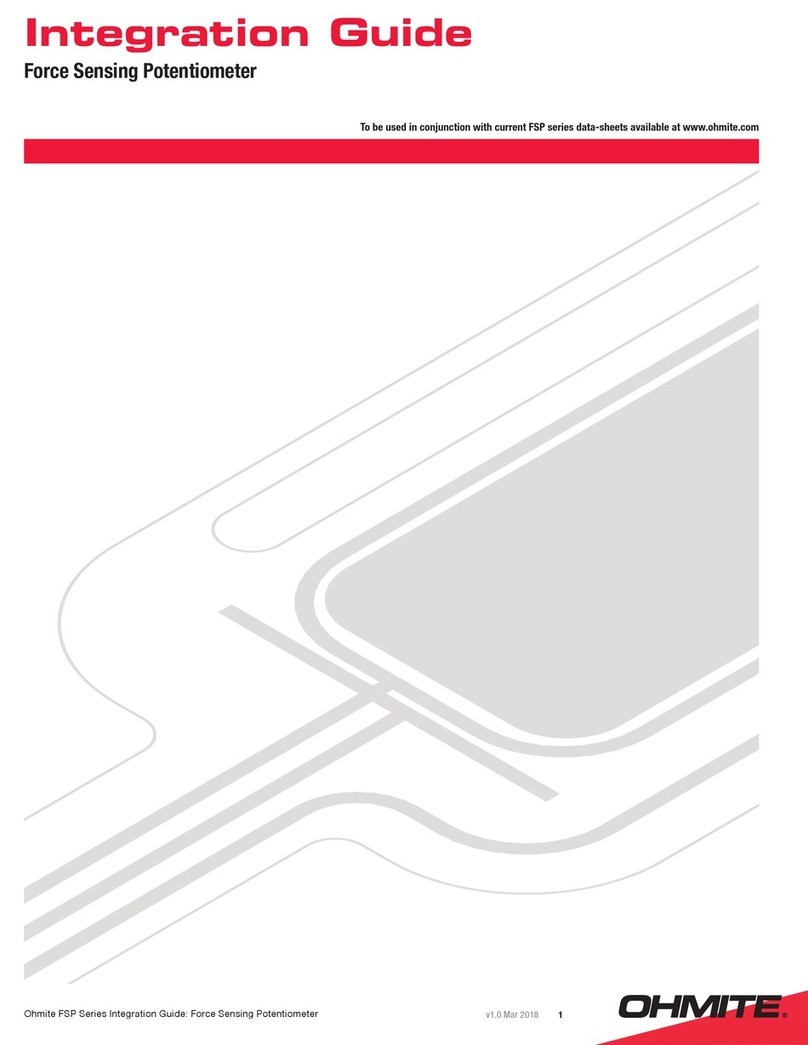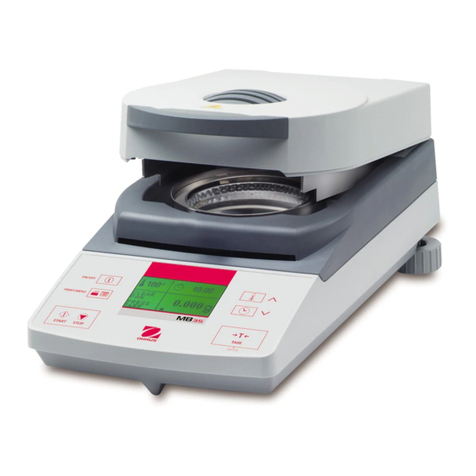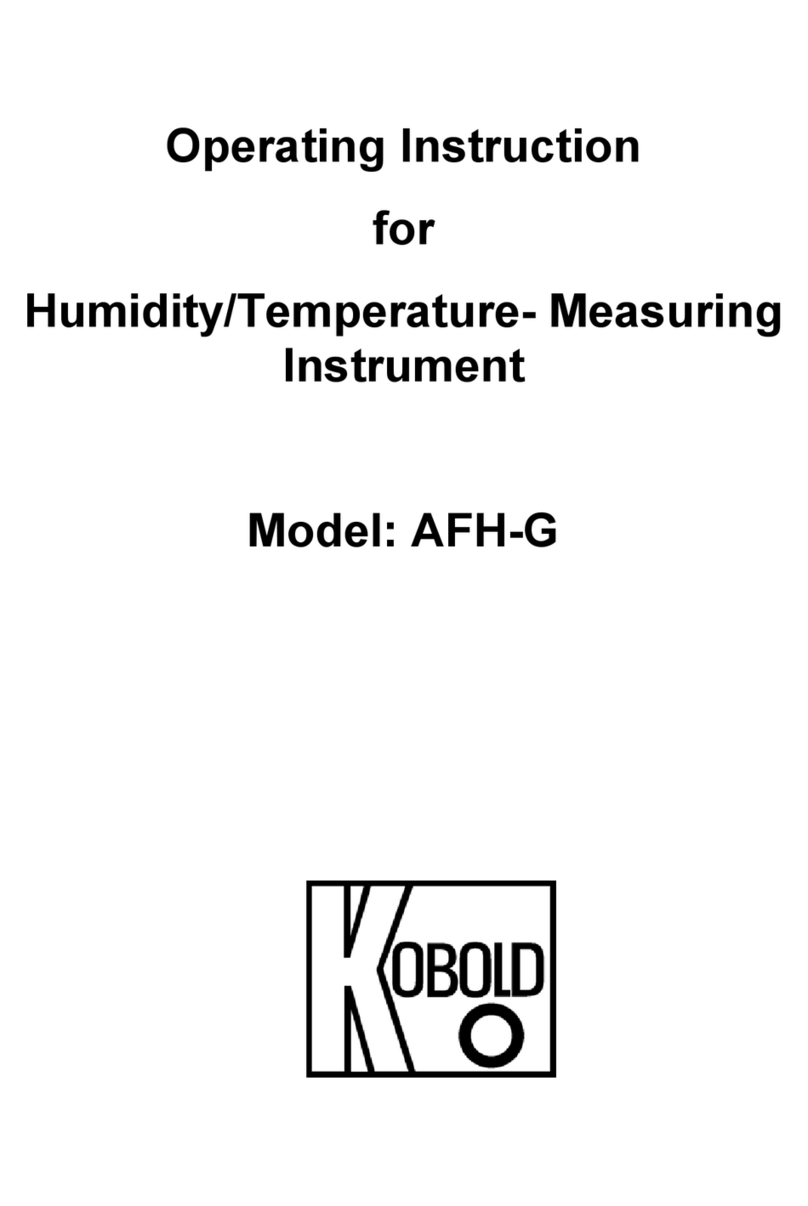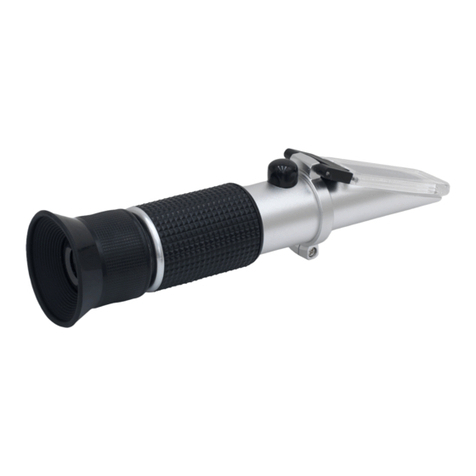Enerdis mDIGI2-TAC User manual

PROGRAMMABLE TACHOMETER
µDIGI2-TA
C
INSTRUCTIONS MANUAL
Code:
Edición:
15
With the setting of "INP1" and "DSP1", the instrument should be able to operate correctly. Notwithstand, depending on the system
characteristics, it may be necessary to modify the internal measurement times.
A
fter programming the "DSP1" parameter with decimal point, a push of
ENTER
of approx. 3s provides access to set the numerical
values of sam
p
lin
g
and limit times.
SAMPLING TIME (TIME)
With irregular input signals, the display may present fluttering
or unwanted variations due that the number of input cycles
detected at each reading are not equal.
The "TIME" parameter allows stretching the measurement
interval while making an average of the readings taken along
the programmed time. This reduces possible display jittering.
T
he sampling time is programmable from 0.0 to 9.9 seconds.
A
value of 0.0 means that no average will be made. It is set
at the factory to 1 second.
T
o help stabilizing the display in case of irregular input
signals it is recommended to increment this parameter, taking
into account that the display readout will be update at the
programmed time.
The sampling time can be reduced, if the input signal is
stable at the operating frequency, to increment the displa
y
update rate.
LIMIT TIME (LIM)
The limit time, programmable from 1 to 10 seconds, is
applied in order to limitate the waiting time for at least 1
pulse is produced at the input before considering it to be
zero.
T
he limit time is initialized at the reception of each inpu
t
pulse. If no pulse is detected before completion of the
programmed time, the display goes to zero.
T
he instrument is shipped from the factory with a limit time
of 10 seconds.
Decreasing the limit time makes the instrument be able to
respond more quickly to the zero condition when the system
stops but this reduction leads to an increment of the
minimum displayable reading before the display goes to zero.
For example suppose that the desired readout for an inpu
t
frequency of 1KHz is 1000 lit/s.
With a limit time of 10s, the minimum frequency is 0.1Hz and
the display readout at this frequency is 0.1 lit/s. Since this
value would not be readable in a display of 1000 counts, the
limit time could be reduced to 1s, so the minimum frequenc
y
will be 1Hz and the minimum readout before displaying zero
will be 1 lit/s.

The first menu parameter allows selection between two display modes.
T
he direct mode must be selected when the display readout and the input frequenc
y
are to be in a direct proportion, that is, the display goes high as the frequency grows.
T
he reverse mode should be selected when reading variables that are inversel
y
proportional to the input frequency.
Press to change the previously selected option if desired (dir = direct mode,
inv = reverse mode) and press
ENTER
to validate the choice and advance to the nex
t
programming phase.
T
he indication shown in figure 18.3 is viewed for 2s before passing to the inpu
t
frequency programming phase. After 2s or by a press of
ENTER
, the display shows an
y
numerical value (depending on previous setting) with the first digit in flash.
If desired to modify this value, press to vary the flashing digit from 0 to 9, and
the key to advance to the next digit to be modified. Repeat these operations
until the display reads the required value and press
ENTER
to save the entry in the
memory; the decimal point goes in flash. Press repeatedly the key to move the
decimal point to the desired position if required.
Press
ENTER
to save changes and go to the next programming phase.
From the Pro stage (see fig. 15.1), press
ENTER
to get access to the different
configuration modules (InP = input, dSP = display, and, if option installed, SEt =
setpoints). Select the display module by a press of (the indication given in
figure 18.1 appears on the display).
Press
ENTER
to enter this module.
16
[18.2] Display mode
UP SHIFT DAT
A
ENTER
12
[18.3] Input frequenc
y
UP SHIFT DAT
A
ENTER
12
RATE METER PROGRAMMING INSTRUCTIONS
[18.1] Display module
UP SHIFT DAT
A
ENTER
12

DIGITAL PANEL INSTRUMENT µDIGI2 FAMILY
µDIGI2-TAC
2
INDEX
1 . MODELS µD-TAC OVERVIEW .......................................................................................................................................... 3
1.1. – FRONT-PANEL DESCRIPTION .................................................................................................................. 4-5
2 . SETUP AND OPERATION................................................................................................................................................. 6
2.1 – POWER SUPPLY AND CONNECTORS ......................................................................................................... 7-8
2.2 – PROGRAMMING INSTRUCTIONS.................................................................................................................. 9
2.3 – INSTRUMENT SETUP..................................................................................................................................10
2.4 – INPUT CONNECTION.............................................................................................................................11-12
2.5 – INPUT CONFIGURATION............................................................................................................................13
2.6 – DISPLAY CONFIGURATION.........................................................................................................................14
2.6.1 – RATE METER CONFIGURATION .............................................................................................14-17
2.6.2 – RPM METER CONFIGURATION...............................................................................................18-20
2.7 – SETPOINTS CONFIGURATION ...............................................................................................................21-23
2.8 – PROGRAMMING LOCKOUT..........................................................................................................................24
3 . SETPOINTS OPTION......................................................................................................................................................25
4 . TECHNICAL SPECIFICATIONS ........................................................................................................................................26
4.1 - DIMENSIONS AND MOUNTING....................................................................................................................27
17
The sampling time (two digits with a decimal place, see page 17) is present on the
display after the symbol shown in figure 19.2.
Use the and procedure to modify the initially programmed value (from
0.1 to 9.9 seconds). Press
ENTER
to validate the entry and pass to the limit time
programming phase.
[19.2] Sampling time
UP SHIFT DAT
A
ENTER
12
A
fter programming the input frequency, a press of “ENTER” provides access to
program the desired display for this frequency. The indication given by figure 19.1 is
shown for 2s before giving access to set the numerical value. Proceed as in section
18.3. ( increments digit value, changes digit) until the display registers
the desired value. Press
ENTER
to make the decimal point flash and use to
move it to the desired location. Finally press
ENTER
to save and go to the run mode.
T
o have access to the programming of the sampling and limit times (see page 17),
hold down the
ENTER
key for 3 seconds, at the end of which the indication shown on
next figure appears on the display.
[19.1] Desired displa
y
UP SHIFT DAT
A
ENTER
12
A
press of “ENTER” made at previous step makes the display show the symbol
corresponding to the limit time program step (see figure 19.3) followed, after 2s b
y
the previously programmed numerical value with the first of its two digits in flash.
Use the and procedure to modify the initially programmed value (from 1
to 10 seconds). Press
ENTER
to validate the entry and automatically return to the
normal operation.
[19.3] Limit time
UP SHIFT DAT
A
ENTER
12

2.6.2 RPM TACHOMETER PROGRAMMING
18
PULSES PER REVOLUTION (PPR)
T
he “PPr" parameter is the number of pulses given by a
complete revolution of the sensor connected to the
instrument’s input.. It is programmable from 1 to 9999.
RESOLUTION (DCP)
T
he "dCP" parameter allows setting the display resolution to
units (without decimal point) or to tenths (with one decimal
place).
EXAMPLE
It is desired to display the rate of a turning shaft that delivers
50 pulses per each revolution.
A
s the only necessary parameter, the "PPr" (pulses pe
r
revolution) must be programmed to 50. The "dCP" parameter
should be set to the desired resolution according to the max.
reading.
With the setting of "PPr" and "dCP" the instrument should be
able to operate correctly, notwithstand, depending on sensor
characteristics, it may be necessary to adjust the internal
sampling and limit times.
A
fter programming "dCP", a push of “ENTER” of 3s gives
access to program these parameters.
SAMPLING TIME (TIME)
With irregular input signals, the display may present fluttering
or unwanted variations due that the number of input cycles
detected at each reading are not equal.
The "TIME" parameter allows stretching the measuremen
t
interval while making an average of the readings taken along
the programmed time. This reduces possible display jittering.
T
he sampling time is programmable from 0.0 to 9.9 seconds.
A
value of 0.0 means that no average will be made. It is set at
the factory to 1 second.
LIMIT TIME (LIM)
T
he limit time, programmable from 1 to 10 seconds, is applied
in order to limitate the waiting time for at least 1 pulse is
produced at the input before considering it to be zero.
The limit time is initialized at the reception of each input pulse.
If no pulse is detected before completion of the programmed
time, the display goes to zero.
T
he instrument is shipped from the factory with a limit time o
f
10 seconds.
Decreasing the limit time makes the instrument be able to
respond more quickly to the zero condition when the system
stops but this reduction leads to an increment of the minimum
displayable reading before the display goes to zero.

T
he indication shown in figure 21.2 is viewed for 2s before entering in the
programming phase for the number of pulses per revolution (PPr). This value can be
set from 1 to 9999 ppr. After 2s or by a press
ENTER
, the numerical value appears on
the display with the first digit in flash. To modify this value, press to increment
the flashing digit until it takes desired value and press to pass to the next digit
to be modified. Repeat these operations until desired value is completed on the
display and press
ENTER
to go to the next programming phase.
From the Pro stage (see fig. 15.1), press
ENTER
to get access to the different
configuration modules (InP = input, dSP = display, and, if option installed, SEt =
setpoints). Select the display module by a press of (the indication given in
figure 21.1 appears on the display).
Press
ENTER
to enter this module.
This manual describes the models µDIGI2-TAC instrument is
small format.
In this manual model is referred with the generic name o
f
µD-TAC.
Models µD-
T
AC are fully configurable by software to measure
rpm or rate in the desired units. The input stage admits direc
t
connection of several sensor types which are selected by a
DIP-switch.
T
he basic instrument is a soldered assembly composed of the
main board, and the display and keyboard module.
Optionally, it can be equipped with a 2-relay control output
card (2RE). This option provides an output connector at the
rear of the meter, status LED’s visible from the front and
specific programming routines which are enabled automatically
once the card is installed.
The outputs are isolated from signal input and power supply.
1. MODEL µDIGI2-
T
AC
3
19
[21.2] Pulses per revolution
UP SHIFT DAT
A
ENTER
12
[21.1] Display module
UP SHIFT DAT
A
ENTER
12
TACHOMETER CONFIGURATION (RPM)
This instrument conforms the following community standards: 89/336/CEE and 73/23/CEE
WARNING: Refer to the instructions manual to preserve safety protections.

A
press of “ENTER” made at previous step gives access to set the resolution of the
display, after the 2s flag indication shown in figure 22.1 (dCP). Available options are
"1" = reading without decimal point and "0.1" = reading with one decimal place.
Press if wanted to change the option present on the display. Press
ENTER
to
save the entry and return to the run mode.
To have access to the programming of the sampling and limit times (see page 20),
hold down the
ENTER
key for 3 seconds, at the end of which the indication shown on
next figure appears on the display.
The sampling time (two digits with a decimal place, see page 20) is present on the
display after the symbol shown in figure 22.2.
Use the and procedure to modify the initially programmed value (from
0.1 to 9.9 seconds). Press
ENTER
to validate the entry and pass to the limit time
programming phase.
A
press of “ENTER” made at previous step makes the display show the symbol
corresponding to the limit time program step (see figure 22.3) followed, after 2s b
y
the previously programmed numerical value with the first of its two digits in flash.
Use the and procedure to modify the initially programmed value (from 1
to 10 seconds). Press
ENTER
to validate the entry and automatically return to the
normal operation.
4
20
[22.1] Resolution
UP SHIFT DAT
A
ENTER
12
[22.2] Sampling time
UP SHIFT DAT
A
ENTER
12
[22.3] Limit time
UP SHIFT DAT
A
ENTER
12
FRONT-PANEL FUNCTIONS DESCRIPTION (RUN MODE)
LED SET1
Indicates setpoint 1 status.
KEY UP
Disabled in run mode.
DISPLA
Y
Displays the variable being measured.
KEYBOARD IN RUN MODE LABEL
Engineering units.
KEY DAT
A
Shows programming data.
Gives access to PROG mode.
KEY SHIF
T
Disabled in run mode.
LED SET2
Indicates setpoint 2 status.
UP SHIFT DATA
ENTER
12

5
21
FRONT-PANEL FUNCTIONS DESCRIPTION (PROG MODE)
KEY
Gives access to the setpoint values.
Increments the active digit value.
DISPLAY
Shows programming parameters.
KEYBOARD IN PROG MODE LABEL
Engineering units
KEY EN
T
ER
Validates programmed data.
A
dvances one pro
g
ram step.
Exits from the programming mode.
KEY
Shifts to the ri
g
ht.
LED SET1
Indicates programming
of the setpoint1.
LED SET2
Indicates programming
of the setpoint2.
UP SHIFT DATA
ENTER
12
2.7 SETPOINT CONFIGURATION (accessible if 2RE option is installed)
If a two relay option is installed (see page 23) the instrument will allow to enter on the following routines: activation mode, dela
y
or hysteresis and setpoint program lockout.
From the Pro stage (see fig. 15.1), press the key to acceed to the setpoint configuration module, indication "SET".
The setpoint numerical values, from the run mode press
ENTER
to recall the Pro stage and press to acced the first setpoin
t
value.
T
he indication shown in figure 23.1 appears on the display to indicate that the next
step is to program the setpoint1 operating parameters (led Setpoint 1 activated). Afte
r
2 seconds or by a press of
ENTER
, the meter allows access to this menu.
T
he display then shows two digits: the leftmost one corresponds to the output mode
(HI or LO) and the rightmost one corresponds to the delay unit (time -delay- or counts
of display -hysteresis-) according to the table below the figure. Use the key to
change the active digit value (in flash) and the key to go to the next digit to be
set.
Press
ENTER
to validate selections and advance to the next phase.
[23.1] Setpoint 1 Configuration
UP SHIFT DATA
ENTER
12
Depending on previous phase choice, the display will show for 2 seconds the
indication corresponding to the selected delay units before giving access to the time
delay or hysteresis magnitude programming (dLY) or (HYS). After 2 seconds or by a
press of
ENTER
, the initially programmed numerical value appears on the display with
the first digit in flashing. To program the desired value (from 0 to 9999 counts o
f
hysteresis or from 0 to 99 seconds of time delay) use the key to increment the
active digit value and the key to advance to the next digit to be modified.
Repeat this procedure until desired value is completed on the display and press
ENTER
to validate and acceed to the programming of the setpoint 2 parameters.
[23.2] SET1 Hysteresis/Dela
y
UP SHIFT DATA
ENTER
12
LEFT DIGIT
VALUE RIGHT DIGIT
VALUE
MODE HI=0
MODE LO=1 DELAY=0
HYSTERESIS=1

6
22
PACKING CONTENTS
Instructions manual in English including Declaration o
f
Conformity.
The digital panel instrument µD-TAC.
Accessories for panel mounting (sealing gasket and fixing
clips).
Accesories for wiring connection (removable terminal bloc
k
connectors and fingertip).
Wiring label sticked to the instrument’s case µD-TAC
Set of 4 labels with different engineering units.
Check packing contents.
CONFIGURATION
Power supply (pages 9 & 10)
T
he instruments for 115/230V AC power supply, are set
up at the factory for 230V AC. (USA market 115 V AC).
T
he instruments for 24/48V AC power supply, are set up
at the factory for 24V AC.
If the instrument is supplied for 12V DC, 24V or 48V DC
power supply, it is not necessary to make any change.
Check wirin
g
label before connectin
g
the instrument t
o
the supply.
2. OPERATING INSTRUCTIONS
Programming instructions (page 11)
T
he software inside the instrument allows configuring the
input and display parameters. If a two-relay output option
is installed ref. 2RE (page 27), the software detects it on
power up enabling a specific routine for setpoints
configuration.
Read carefully this parragraph.
Input type (page 12-15)
T
he instrument provides an input for several sensor types
including magnetic pickup, Namur, NPN/PNP type and
TTL/24V DC (see page 13).
Check the 5-position DIP-switch located on the mai
n
board.
Programming lockout (page 26)
As shipped from the factory, the instrument allows full
access to change programming parameters.
T
o disable the possibility of making changes on the
configuration, it is necessary to remove a plug-in jumpe
r
located on the main board.
Check jumper position.
The figure 24.3 shows one of the two options available at this stage [LC O = setpoin
t
values programming enabled (unlocked) or LC 1 = setpoint values programming
disabled (locked)].
If wanted to modify this parameter, use the key to switch to the desired
option. If you decide to lock the setpoint values, it will be also necessary to lock out
the entire program routines (see page 18).
Press
ENTER
to validate the choice, save programmed data and return to the run
mode (indication Stor).
[24.3] Setpoint Program lockout
UP SHIFT DATA
ENTER
12
T
he indication shown in figure 24.1 appears on the display to indicate that the next
step is to program the setpoint 2 operating parameters (led Setpoint 2 activated).
A
fter 2 seconds or by a press of
ENTER
, the meter allows access to this menu.
T
he display then shows two digits; the one on left corresponds to the output mode
(HI or LO) and the rightmost one to the delay unit (time -delay- or counts of displa
y
-hysteresis-). See table in figure 20.1. Use the key to change the active digit
value (in flashing) and the key to go to the next digit to be modified.
Press
ENTER
to validate changes and advance to the next phase.
[24.1] Setpoint 2 Configuration
UP SHIFT DATA
ENTER
12
The display shows for 2 seconds the indication corresponding to the selected delay
units before giving access of the time delay or hysteresis magnitude programming
(dLY) or (HYS). After 2 seconds or by a press
ENTER
, the initially programmed
numerical value appears on the display with the first digit in flashing. To change the
value (from 0 to 9999 counts of hysteresis or from 0 to 99 seconds of time delay) use
the key to increment the active digit value and the key to advance to
the next digit to be modified. Repeat this procedure until desired value is completed
on the display and press
ENTER
to validate and advance to the next step.
[24.2] SET2 Histeresis/Dela
y
UP SHIFT DATA
ENTER
12
LEFT DIGIT
VALUE RIGHT DIGIT
VALUE
MODE HI=0
MODE LO=1 DELAY=0
HYSTERESIS=1

Program setpoint 1 value, LED 1 activated.
T
he initially programmed value appears on the display with the first digit flashing.
Press repeatedly the key to increment the active digit from 0 to 9 until it takes
the desired value and press to advance to the next digit to be modified. Repea
t
these operations to complete the desired setpoint value with sign.
Press
ENTER
to validate the entry and pass to the programming of setpoint 2.
[25.2] Setpoint 1
UP SHIFT DATA
ENTER
12
Program setpoint 2 value, LED 2 activated.
Program the setpoint 2 value with sign by means of the (change value) and
(change digit) procedure as described in previous phase.
Press
ENTER
to store programmed data in the memory and exit from the
programming mode.
[25.3] Setpoint 2
UP SHIFT DATA
ENTER
12
To program the setpoint values, press
ENTER
to acceed the programming mode
(indication Pro, figure 25.1) and press to make the display show the previousl
y
programmed value of setpoint 1.
NOTE: The setpoint values should be programmed within the selected measuremen
t
range.
[25.1] Setpoints Programming
UP SHIFT DATA
ENTER
12
7
Fi
g
. 9.1. Disassembly.
2.1 – Power supply and connectors
T
o change the meter’s physical configuration remove the case as
shown in figure 9.1.
115/230 V AC: The instruments with 115/230 V AC power are
set up at fabrication for 230 V AC (USA market 115 V AC), see
figure 9.2. To change power supply configuration to 115 V AC,
make the jumpers indicated in figure 9.3 and table 1. The wiring
label should be modified to match the new configuration.
24/48 V AC: The instruments with 24/48 V AC power are set up
at fabrication for 24 V AC, see figure 9.2. To change power
supply configuration to 48 V AC, make the jumpers indicated in
figure 9.3 and table 1. The wiring label should be modified to
match the new configuration.
12, 24 or 48V DC:
Instruments for DC
power are set up for
the supply voltage
specified in the wiring
label (12V, 24V or 48
V
according to the orde
r
reference).
Tabla 1. Jumper settings.
Pin 1 2 3 4 5
230V AC -
115V AC -
48V AC -
24V AC -
Fi
g
. 9.3. Jumper settin
g
s for 115 V or 24 V A
C
Fi
g
. 9.2. Jumper settin
g
s for 230 V or 48 V A
C
23

CONNECTORS
To perform wiring connections, remove the
terminal block from the meter’s connector, strip
the wire leaving from 7 to 10mm exposed and
insert it into the proper terminal while pushing
the fingertip down to open the clip inside the
connector as shown in the figure.
Proceed in the same manner with all pins and plug the terminal bloc
k
back to the corresponding meter’s connector.
Each terminal can admit wires of section between 0.08 mm² and 2.5
mm² (AWG 26 ÷ 14).
Some terminals have removable adaptors to provide proper fastening for
wires of sections less than 0.5 mm².
POWER CONNECTION
AC VERSIONS
PIN 1 – AC PHASE
PIN 2 – GND (GROUND)
PIN 3 – AC NEUTRAL
DC VERSIONS
PIN 1 – DC POSITIVE
PIN 2 – Not connected
PIN 3 – DC NEGATIVE
8
24
INSTALLATION
To meet the requirements of the directive EN61010-1, where the uni
t
is permanently connected to the mains supply it is obligatory to install
a circuit breaking device easy reachable to the operator and clearl
y
marked as the disconnect device.
WARNING
In order to guarantee the electromagnetic compatibility, the following
guidelines should be kept in mind :
- Power supply wires may be routed separated from signal wires.
Never run power and signal wires in the same conduit.
- Use shielded cable for signal wiring and connect the shield to the
ground of the indicator (pin2 CN1).
- The cables section should be ≥0.25 mm
2
If not installed and used in accordance with these
instructions, protection against hazards may be impaired.
2.8 – Programming lockout
A
fter completing the instrument’s programming, it is
recommended to lockout the access to the programming to
prevent from accidental or unauthorized modifications.
This operation is made by taking off a plug-in jumper located
on the main board circuit (see figure at right).
NOTE : Disconnect power before changing
the jumper position.
While the instrument is locked out it is however possible to
acceed to the programming routines to check the current
configuration, but it won’t be possible to entry or modify data.
In this case, a push of
ENTER
to acceed the programming
routines will show the indication dAtA instead of Pro.
Remove jumper to
lock out the programming

9
25
2.2 – Programming Instructions
To enter in the programming mode
Connect the meter to the main supply, for approx. 1s a self-test routine automatically activates all the digits of the display. After,
the instrument goes to the normal operating mode (RUN).
To enter in the programming mode press for 5 seconds until the the indication Pro shown in figure 11.1 appears on the display.
To exit from the programming mode
To return to the run mode, it is necessary to pass through the different menu steps by successively pressing the
ENTER
key until
the meter displays the indication Stor while internally stores the programmed parameters into the memory. After, it automatically
goes to the normal operating mode.
How to interpret the programming instructions
The programming software routine is composed by a series of hierarchically organized menus, each allowing the setting of a
specific parameter. In general, the normal sequence at each step is to push the key a number of times to make changes
and the
ENTER
key to store them in the memory and advance to the next step.
The elements used along the programming instructions are described following.
T
he programming instructions for each menu step are accompanied by a figure
representing the display indication for the corresponding parameter. Pay special
attention to the LED indications and active keys and follow the procedure described on
the text to introduce correctly the desired data.
When the display indication is represented with blank segments, it means that this is
one of the possible options of this menu (normally the default one) depending on the
previous selection.
A
series of blanked ‘8’ represents any numerical value that can be changed by use o
f
keys (change digit) and (change value).
[11.1] Programming Method
UP SHIFT DATA
ENTER
12
3. RELAY OUTPUT OpTION
A
s an option, the µD-
T
AC models can be equipped with the
following output option:
• A control output card with two SPDT relay outputs rating 8
A
@ 250 V AC / 150 V DC. The outputs can be programmed fo
r
HI or LO operation and selectable time delay or hysteresis
action. Ref. 2RE
T
he 2RE option consists of an additional card installable to the
meter’s main board by means of a plug-in connector.
T
he option is supplied with a specific instructions manual
describing installation and characteristics. Nevertheless, the
programming instructions are given in the µD-TAC manual.
For more detailed information on characteristics, applications
and mounting, please refer to the specific 2RE instructions
manual.
2-RELAY (2RE)
OUTPUT
OPTION

10
26
4. TECHNICAL SPECIFICATIONS
FUSES (DIN 41661) - (Recommended)
• µD-TAC (230/115V AC).............................F 0.1A / 250 V
• µD-TAC2 (24/48V AC)................................. F 2A / 250 V
• µD-TAC3 (12 V DC)..................................... F 1A / 250 V
• µD-TAC4 (24 V DC)...................................F 0.5A / 250 V
• µD-TAC5 (48 V DC)...................................F 0.5A / 250 V
DISPLAY
• Type.......................................9999, 7-segment red LED
• Junior-TAC .......................................4 digits, 14mm high
• Junior20-TAC....................................4 digits, 20mm high
• Decimal point ...........................................programmable
• LED’s .................................................. 2, setpoint status
• Overrange indication................................................OvE
ENVIRONMENTAL
• Operating temperature..........................-10 ºC to +60 ºC
• Storage temperature.............................-25 ºC to +85 ºC
• Relative humidity (non condensing)........ <95 % at 40 ºC
• Max. altitude .......................................................2000m
DIMENSIONS
• Dimensions ..............................................96x48x60 mm
• Panel cutout.................................................. 92x45 mm
• Weight..................................................................250 g
• Case material .........................polycarbonate s/UL 94 V-0
• Frontal sealing........................................................IP65
INPUT
• Max. frequency......................................................7 KHz
• Min. frequency .....................................................0.1 Hz
• Excitation........................8V @ 20mA or 22V ±5 @ 20mA
Magnetic pickup
• Sensitivity.............................Vin (AC) > 120 mV eff.
NAMUR sensor
• Rc.............................................1 KΩ(incorporated)
• Ion.........................................................< 1 mA DC
• Ioff ........................................................> 3 mA DC
NPN and PNP type sensors
• Rc.............................................1 KΩ(incorporated)
• Logic levels...............“0” < 2.4 V DC, “1” > 2.6 V DC
TTL/24V DC (encoder)
• Logic levels...............“0” < 2.4 V DC, “1” > 2.6 V DC
Contact closure
• Vc..................................................................... 5 V
• Rc..........................................3.9 KΩ(incorporated)
• Fc................................................................100 Hz
A
CCURACY AT 23º ± 5º C
• Max. error..................± (0.01% of the reading +1 digits)
• Temperature coefficient..............................100 ppm/ ºC
• Warmup time..................................................5 minutes
POWER SUPPLY
• AC................................230/115 V, 24/48 V 50/60 Hz AC
• DC......... 12V (10.5 to 16 V), 24V (21 to 32 V), 48V (42 to 64V)
• Consumption........................................................... 3 W
2.3
–
Instrument’s setup
T
he enclosed diagram shows the
complete programming routines
for models µD-TAC.
a) The basic parameters, which
refer to the input and displa
y
configuration are organized into
two modules: "InP" and "dSP".
b) If a 2-relay option is installed
(see page 27), the module "Set",
that allows configuring the option,
is automatically included in the
routines.
c) If a 2-relay option is installed,
the setpoint values programming
is directly entered from the Pro
stage.
A
t the end of each module, the
indication Stor appears while data
is saved in the memory.

To configure the input to the indicator, set the switch SW1 as indicated in the table
2.4
–
INPUT CONFIGURATION
SW1 1 2 3 4 5
Magnetic pickup off off on off off
NAMUR sensor on off on on off
NPN type sensor on on off off off
PNP type sensor on off off on off
TTL/ 24V (encoder) * on off off off on
Contact closure on on on off on
* Factory setup
11
1./ Sensor type switch settings
Before connecting the input signal to the instrument, set the 5-position
DIP-switch SW1 (see figure) according to the sensor type as indicated
in the table below.
To make changes remove the instrument from the case as shown in
figure 9.1.
Fi
g
. 13.1. Main circuit ref. 4
7
4, component sid
e
27
T
o install the instrument into the panel,
make a 92x45mm cutout and insert the
instrument from the front placing the sealing
gasket between this and the front bezel.
Place the fixing clips on both sides of the
case and slide them over the guide tracks
until they touch the panel at the rear side.
Press slightly to fasten the bezel to the panel
and secure the clips.
T
o remove the instrument from the panel,
pull outwards the fixing clips rear tabs to
disengange and slide them back over the
case.
CLEANING: The front cover should
be cleaned only with a soft cloth
soaked in neutral soap product.
DO NOT USE SOLVENTS
4.1 - Dimensions and mounting

12
INPUT SIGNAL CONNECTION (CN2)
PIN 1 = -IN [common (-)]
PIN 2 = +IN [LOW]
PIN 3 = +EXC [24V DC (+)]
PIN 4 = +EXC [8V DC (+)]
PIN 5 = NOT CONNECTED
2./ Signal connections.
Consult wiring advisements given in page 10. 3./ Sensor wiring schematics.
Consult wiring advisements given in page 10.

The display presents the previously selected input type : tAC = tachometer for RPM or
rAtE = rate meter.
To change this parameter, press to switch to the desired option and press
ENTER
to save the choice in the memory and automatically return to the run mode
(indication Stor).
[15.3] Input type
UP SHIFT DATA
ENTER
12
Connect the instrument to the main supply, it automatically enters in a self-test
routine which briefly illuminates all segments and LED’s then shows the software
version and finally goes to the normal reading ("RUN" mode).
Press
ENTER
to acceed the programming mode.
T
he display shows the indication given in fig. 15.1. The LED’s 1 and 2 will flash during
the programming mode (except when programming the setpoints).
Press
ENTER
to have access to the programming parameters.
[15.1] Programming mode
UP SHIFT DATA
ENTER
12
Press
ENTER
to get access to the input configuration module (fig. 15.2).
Other modules (dSP = display, and, if option installed, SEt = setpoints) are selected
by pressing the key.
[15.2] Input Module
UP SHIFT DATA
ENTER
12
2.5 - INPUT CONFIGURATION
A
CCESS TO THE PROGRAMMING MODE
13

The display configuration depends on the input type selected in the input module.
As RATE METER, the display module includes programming of the input frequency with decimal point and the desired displa
y
with decimal point. The display/frequency ratio may be set for direct or reverse operation.
As RPM METER, the only parameter necessary to configure the display is the number of pulses per revolution that delivers
the sensor. Programming is completed with the display resolution.
T
o adjust the display to the particular system characteristics, the display module includes the parameters sampling time and limit
time, which are accessible by holding the “ENTER” key for 3 seconds before exiting from the program routines.
INPUT FREQUENCY (INP1)
T
he "INP1" parameter refers to the input frequency generated
by the transducer. This frequency must be within the specified
limits (0.1Hz to 7KHz) and can be programmed with two, one
or no decimal places.
DESIRED DISPLAY (DSP1)
T
he "DSP1" parameter is the desired display readou
t
corresponding to the frequncy programmed in the “INP
”
phase. The decimal point can be located in any of the digits o
f
the display.
T
he display variation can be directly proportional to the inpu
t
variation (increasing frequency →increasing display) or
inversely proportional (increasing frequency →decreasing
display and vice-versa).
T
he first menu step allows to select one of these modes (dir =
direct, inv = reverse).
2.6.1 RATE METER PROGRAMMING
2.6 - DISPLAY CONFIGURATION
14
EXAMPLE
It is desired to measure the rate in m/s of a conveyor belt
which is driven by a turning shaft of 20 cms diameter and
300 rpm that gives 4 pulses per revolutiion.
In 1 second, the shaft gives 20 pulses (300 rpm = 5
revolutions per second and 1 revolution = 4 pulses). The
input frequency is then 20Hz. At such frequency, the rate o
f
the conveyor belt is :
rpm ×π×d = 300 ×π×20 = 18849.6 cm/min = 3.142 m/s
The INP1 and DSP1 parameters must be : INP1 = 20, DSP1
= 3.142.
T
he display mode must be selected for direct variation with
respect to the input frequency (dIr option).
Table of contents
Other Enerdis Measuring Instrument manuals

